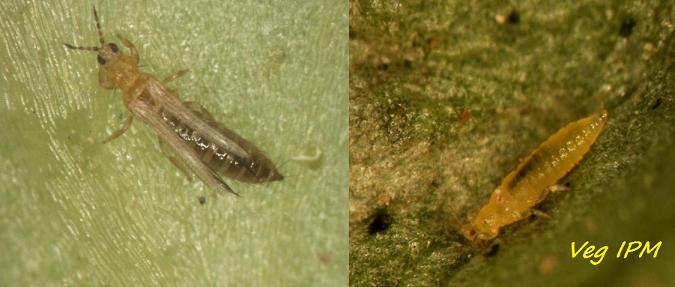 |
|
|
|

|
|||
| |
|||
With the rain we experienced over the weekend, you may likely see a decline in thrips numbers on leafy vegetables. Precipitation amounts varied throughout the area with the highest recorded AZMET levels being recorded in the Gila Valley at 0.46", and the least being recorded at the Roll station (0.14 "). The Yuma Valley received from about 0.40" of rainfall on Saturday. However, as we saw last year with much heavier and more frequent rainfall, these declines can be short-lived. Typically, heavy rainfall with dislodge or even drown adult thrips on plants, and can suffocate larvae in the soil if it remains wet for prolonged periods. Once the plants dry though adults can quickly move back onto plants. Another factor that PCAs should be concerned with this time of the year is thrips "bioconcentration" which occurs each year in late February and March as lettuce acreage declines. This is coincident with an increase in thrips abundance that occurs due to higher temperatures. Each time a lettuce field is harvested and disked, adult thrips populations disperse from these areas into the next available lettuce field. As the number of lettuce acres become reduced at the end of the season, this creates a bottleneck effect that concentrates high numbers of thrips adults on the remaining fields under production. This can often make chemical control very difficult, particularly in March, as thrips may continually re-infest fields following spray applications. Random Notes: Radiant (6-8 oz/ac) and Lannate (0.75 lb) + pyrethroid (high rate) are providing good residual efficacy of thrips in our trials at the Yuma Ag Center. Remember, the key to good thrips control is to prevent immature populations from becoming established. For more information on the identification, biology, ecology and management of thrips on desert produce please read: "Insect Management on Desert Produce Crops: Western Flower Thrips" and "Thrips Management in Desert Leafy Vegetables".
To contact John Palumbo go to: jpalumbo@ag.arizona.edu
|
|||
| Back | |||
For questions or comments on any of the topics please contact Marco Pena at the Yuma Agricultural Center. |
|||
| Home | Cotton
| Veggies | Forages
| Grains | Citrus
| Crop x Crop Insects | Diseases| Weeds | Pesticides | Economics | News | Weather | Research | Photos | Contacts | General Info. Copyright © 2001 University of Arizona, College of Agriculture and Life Sciences Webmaster: Al Fournier (acis@ag.arizona.edu) |
|||
